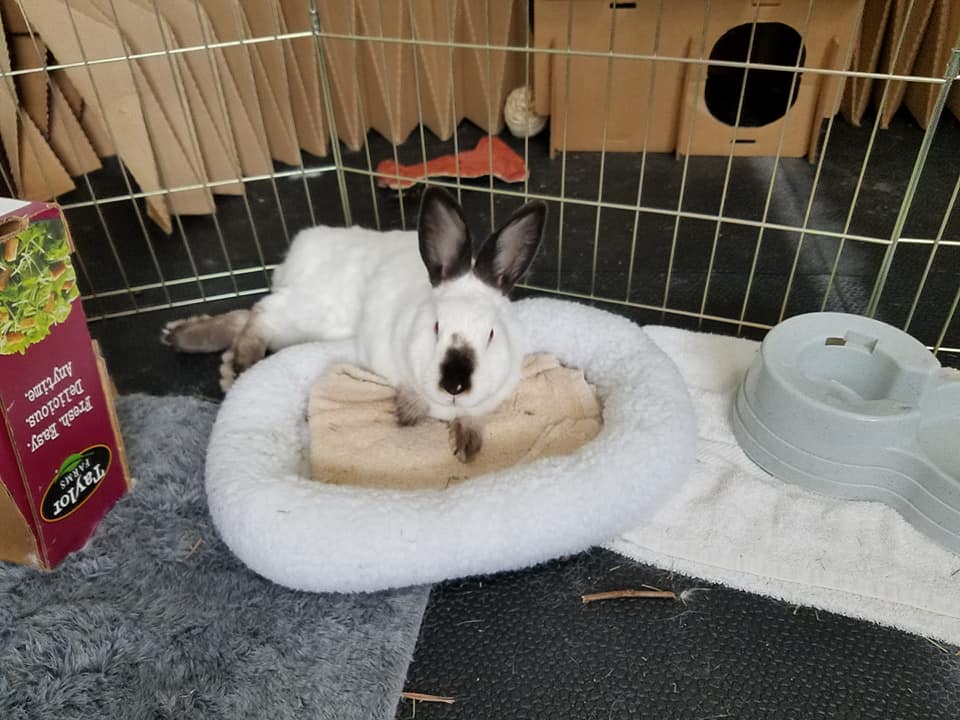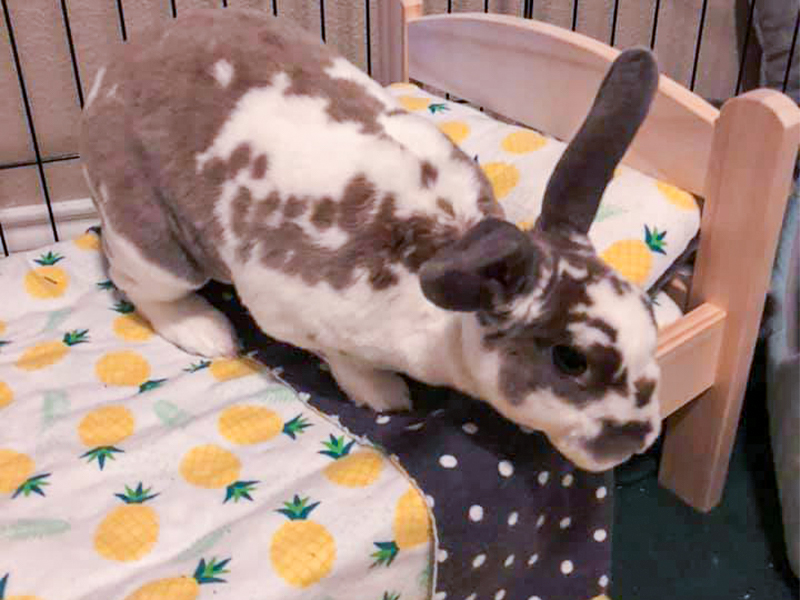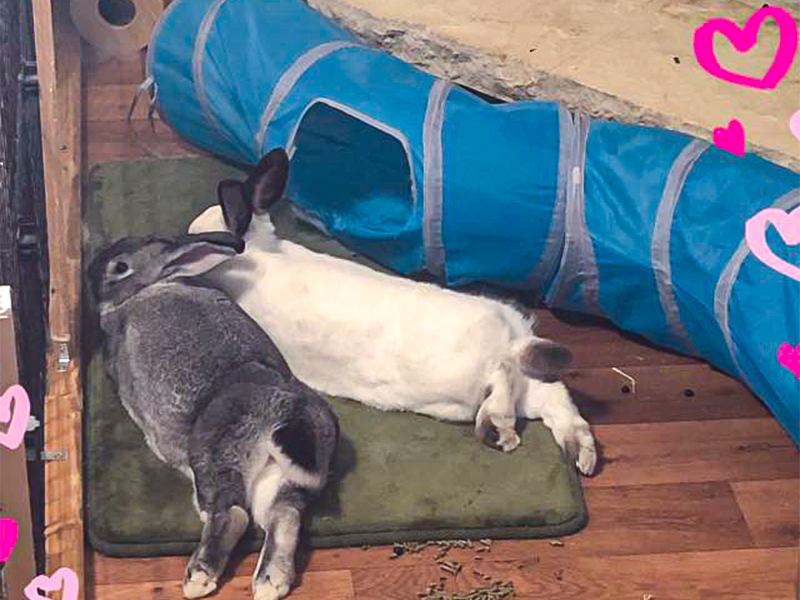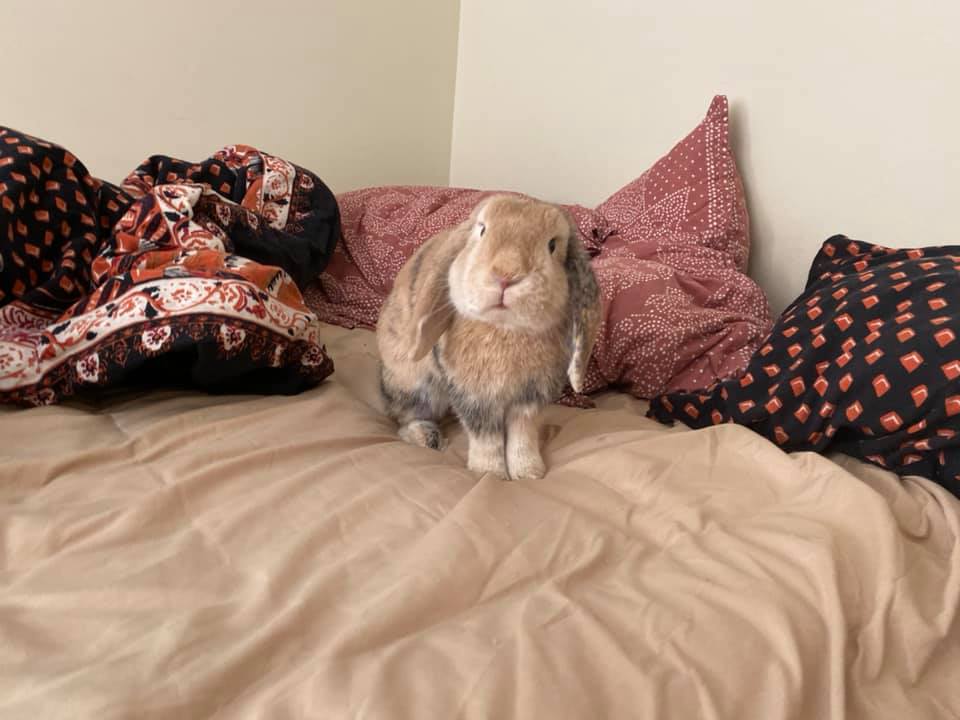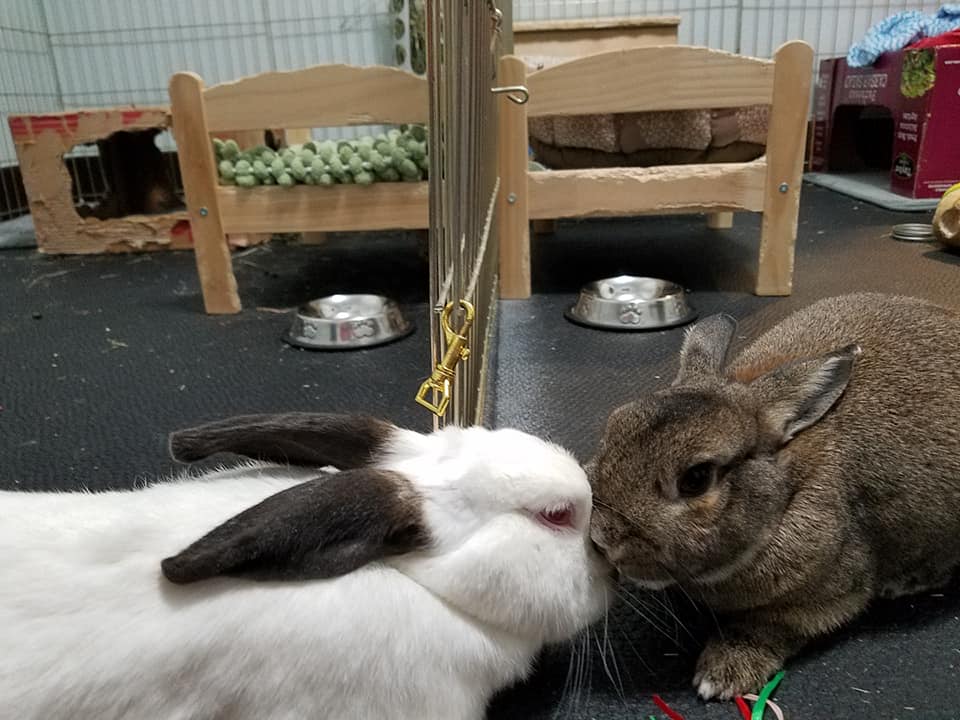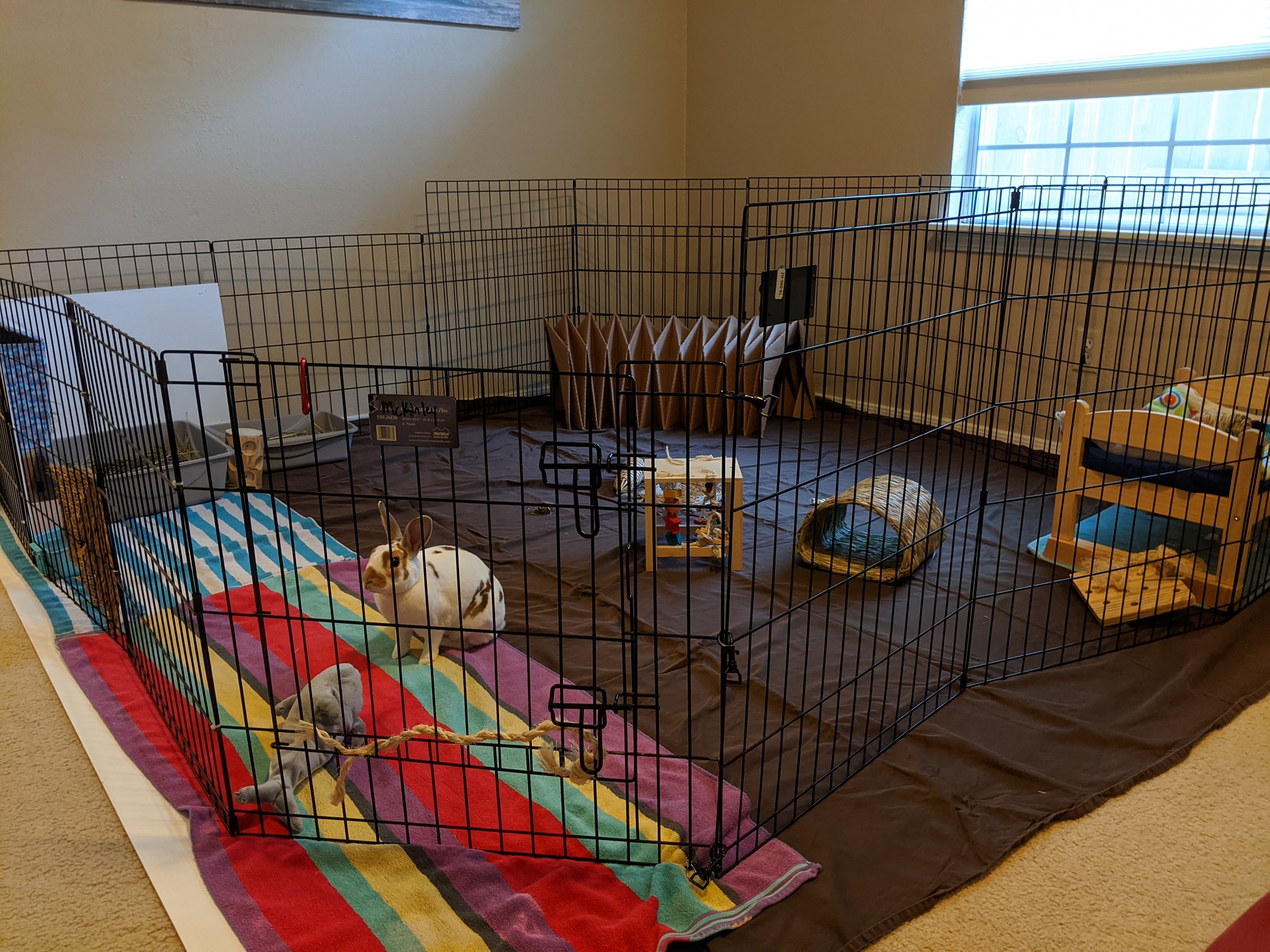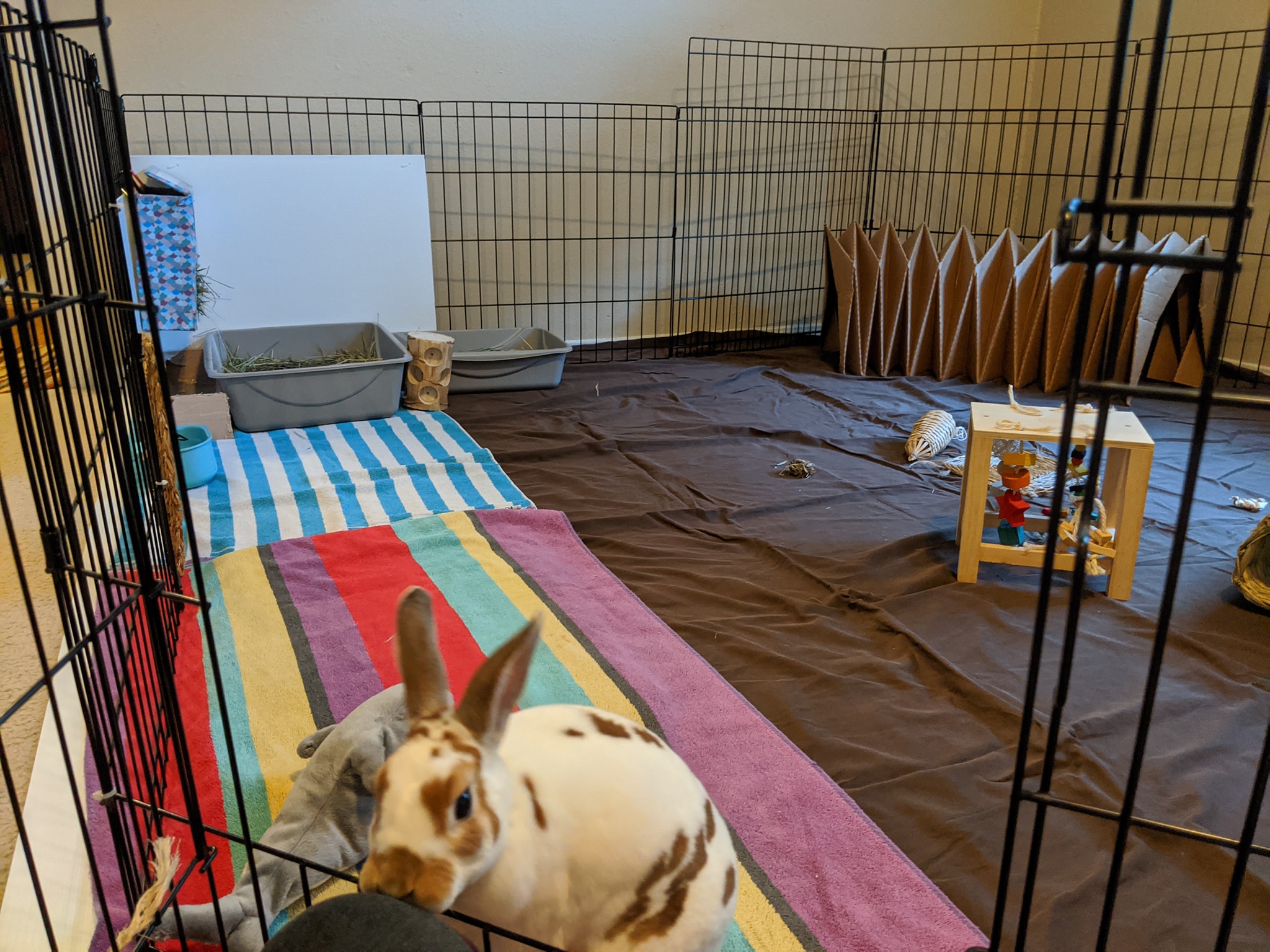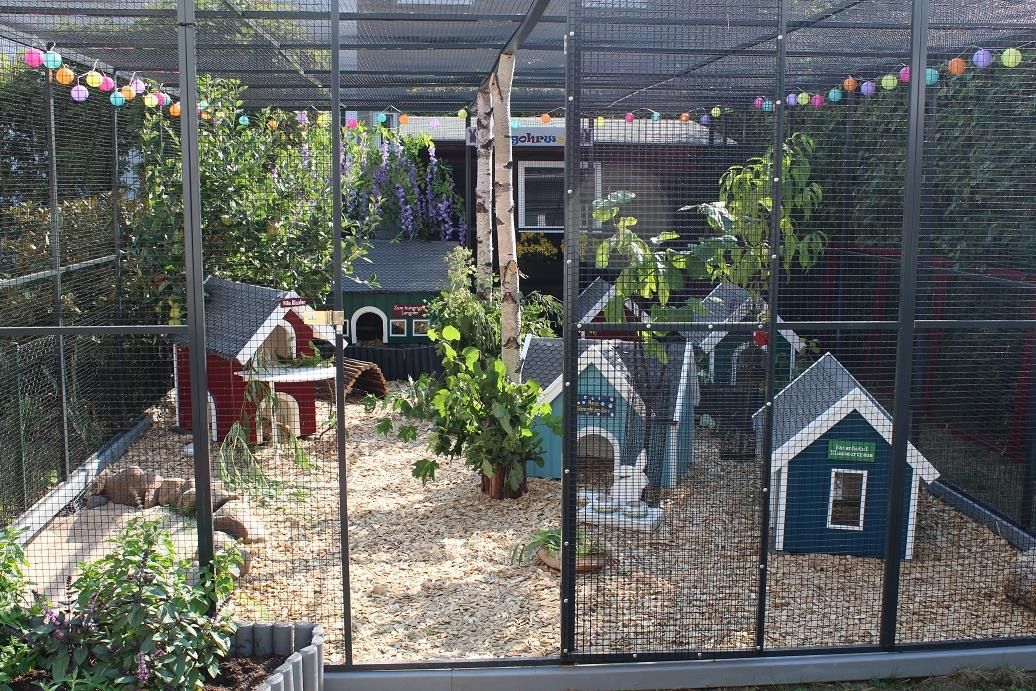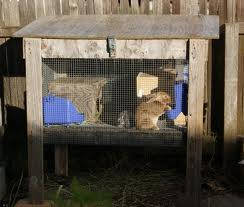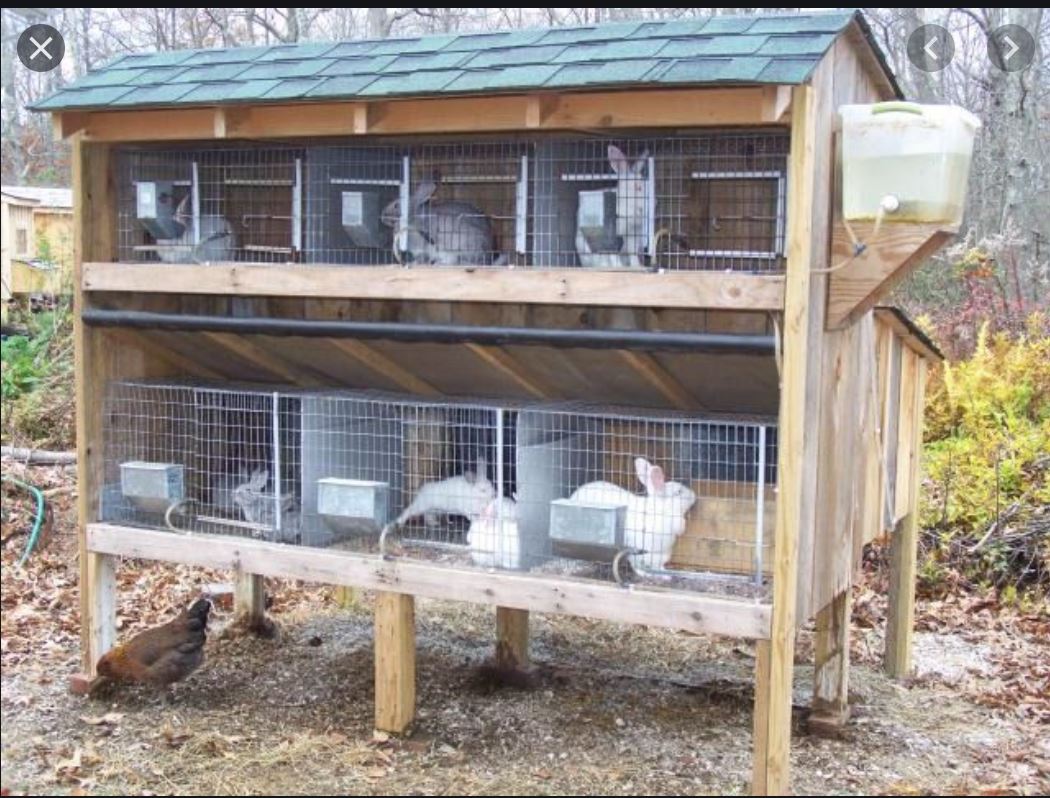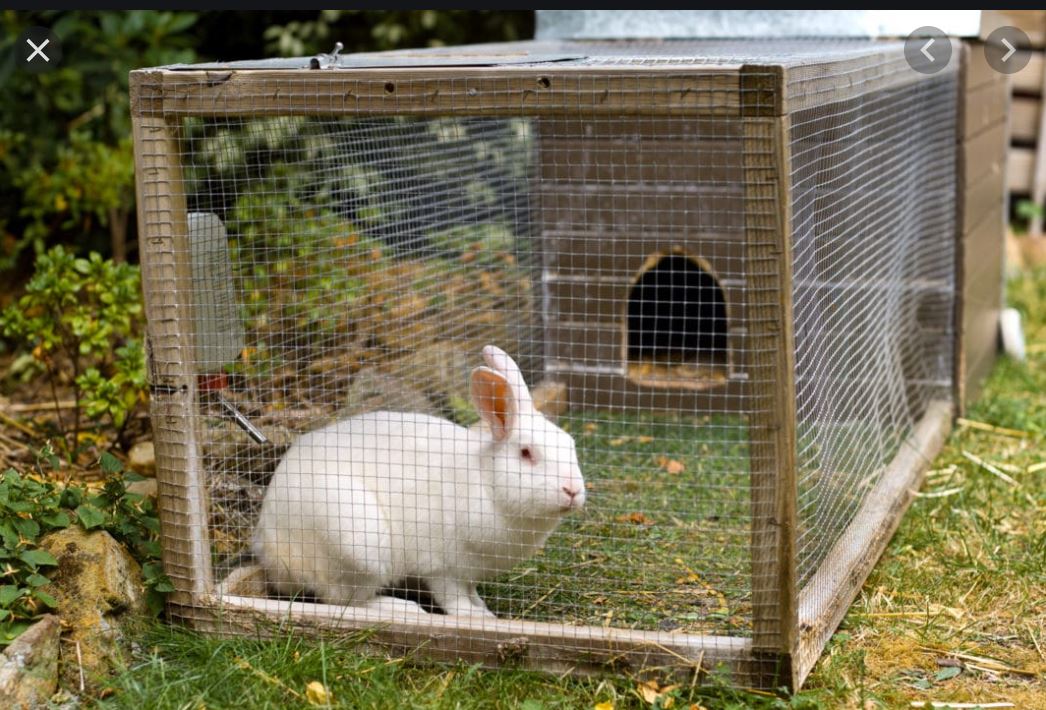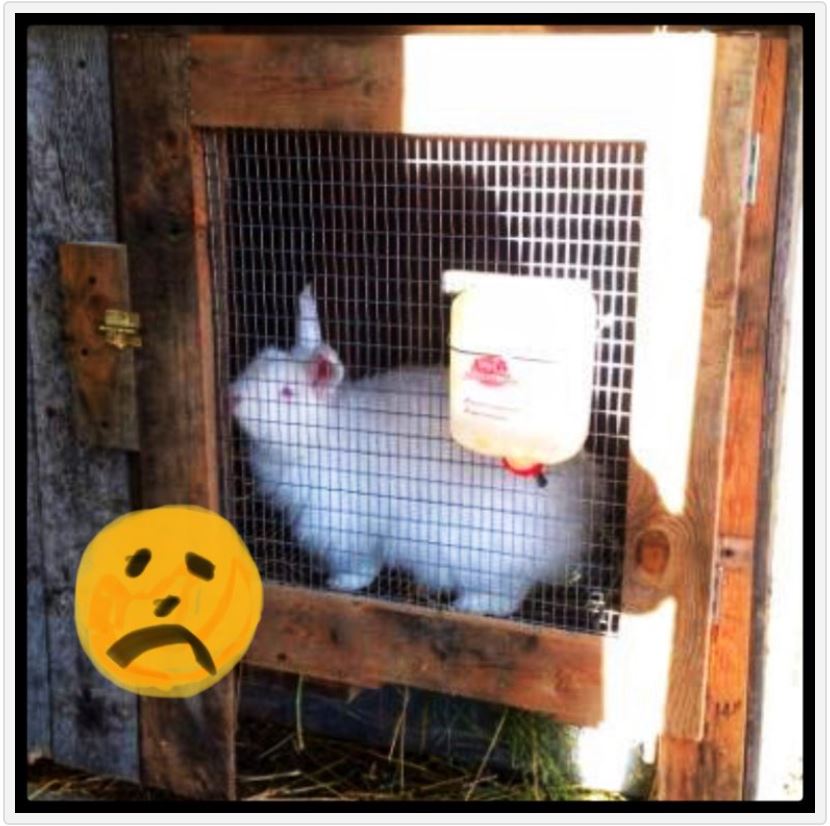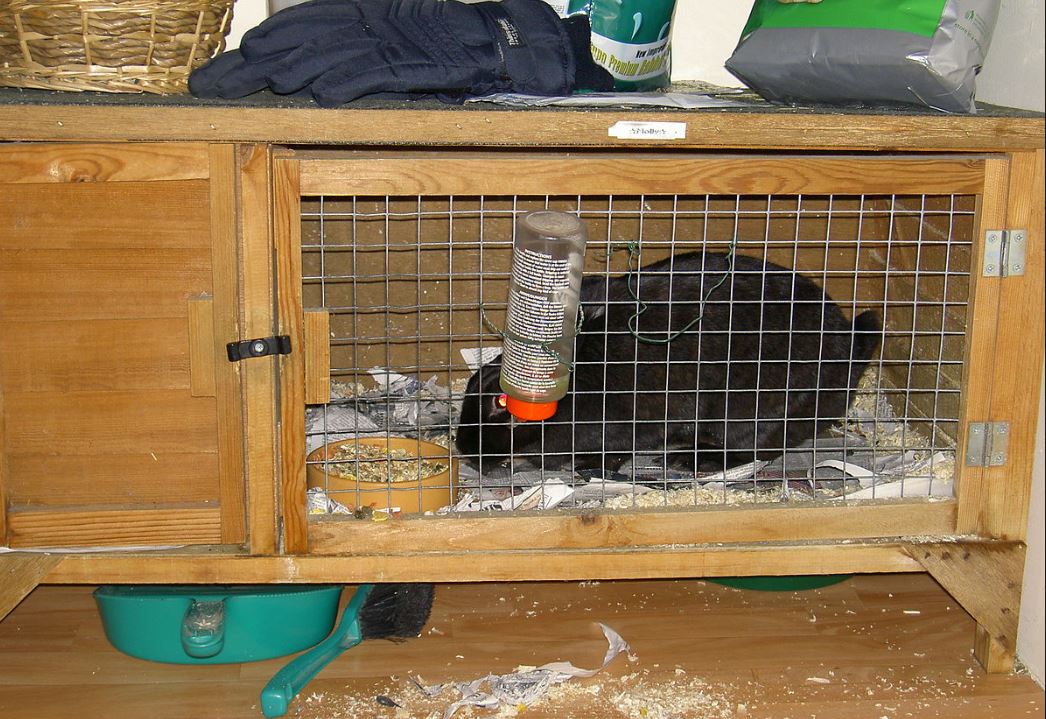Rabbit Care: Why Outside is No Place for a Rabbit
Domestic rabbits should not live outside because there are too many dangers that cannot be controlled or prevented.
This page discusses the various reason why outside is no place for a rabbit to live. We understand many people feel very strongly about this subject and are quick to argue their feelings about the topic. But House Rabbit Resource Network, along with many other rabbit groups who have dedicated their lives to the welfare of domestic house rabbits, all agree that rabbits should not live outside. Research and experience explain why and are discussed below.
WARNING: This page and its contents may make you feel uncomfortable as many of the images are graphic.
We only want to present the information we have in the hopes that it helps others understand our stance on the topic.
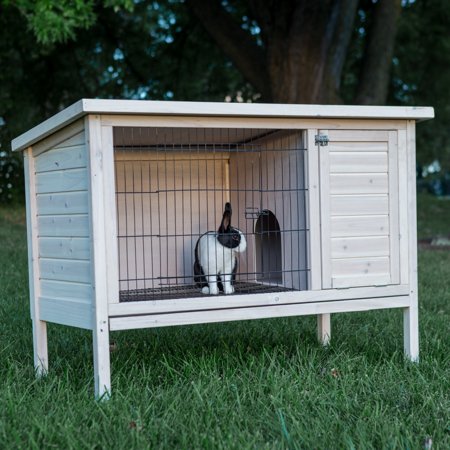
On This Page:
Why Outside is No Place for a Rabbit:
The Common Myth
Most people were raised to believe domestic rabbits should live outside in a small hutch. Many people were given a rabbit as a child, and they kept it outside in a hutch bought from the pet store or feed store. So when we tell them that rabbits should not live outside, they look at us confused and scoff, “My rabbit lived outside in a hutch for years and it was fine.” If we follow up that statement by asking how long their rabbit lived, we usually get the answer of two to five years.
Unfortunately, most people believe rabbits only live five, six–maybe seven, years. When in fact when properly cared for, rabbits live anywhere from ten to fifteen years, easily.
One reason for this deadly misunderstanding is the fact most people were taught that rabbits should live outside. Which in turn shortens the rabbit’s life-span drastically. But when everyone does the same thing, and each rabbit involved only lives a handful of years, it makes sense that generations of people think it’s normal; not realizing what they’re doing is actually the thing shortening the rabbit’s life span.
Whether a rabbit is placed in a small hutch or a spacious custom-designed cage, the outside has too many dangers that we can’t prevent or control.
The sections below discuss the most common dangers to your rabbit lurking outside in your yard.
Why Outside is No Place for a Rabbit:
Overview of Why Rabbits Should Not Live Outside
Rabbits are active, social creatures who need room to zoom around, hop, and binky. They also love a good nap all stretched out and relaxed on a soft mat. Like most animals, rabbits do not belong, nor do they enjoy living life in dark, cramped hutches outside alone.
Before you bring a rabbit home it’s important to think about the quality of life you will provide for them. If your plan is to keep your rabbit outside, in a garage, or another outside building please reconsider. Rabbits are social creatures who want to be a part of your family. So many rabbits have lived and died alone in cramped, isolated cages and hutches outside.
Video Credit: Why It’s Dangerous to Keep Rabbit Outside | Pet Rabbits
Keeping a rabbit outside increases their chances of being forgotten, neglected, becoming sick, or dying.
The average lifespan of a rabbit kept in an outdoor hutch is 3-6 years. The average lifespan of an indoor house rabbit is 8-14 years. Make sure you give your rabbit every chance at a good, healthy, long life.
Not only does living inside extend a rabbit’s lifespan, but rabbits also thrive indoors where they’re part of the family dynamic. Rabbits love to see and hear what’s going on in a household. Living inside also allows rabbits to have a safe, secure place to call their own.
If you want to do right by your rabbit, indoor living is where it’s at. The best thing for rabbits both mentally and physically is to live in the home where they are safe, secure, and socialized with regularly.
Why Outside is No Place for a Rabbit:
Large Predators
It doesn’t matter where you live, predators to your rabbit are everyone. Even suburban neighbourhoods with well-maintained privacy fences can’t keep a determined predator out. If you keep your rabbit outside, it’s just a matter of time before a predator comes knocking. Here is a list of some of the most common large predators that are a danger to your rabbit living outside:
- Fox
- Coyote
- Loose dog
- Feral cat
- Neighbour’s mean cat
- Raccoons
- Weasels
- A really hungry opossum (rare, but can happen).
- Less frequent but still dangerous are your flying predators of the hawk and owl variety.
Outdoor hutches sold at Walmart or Tractor Supply will last a day when faced with a determined predator. Foxes and dogs can easily chomp and tear through wire mesh. Raccoons are handy enough to simply open a door or window and waltz right in. A hand-built cage may offer better protection, but it can’t stop a predator from clawing or biting at the cage. If the cage holds up, the likelihood is high that the terrified rabbit trapped inside will injure itself trying to escape or die of fright. The after-effects of such a traumatic event can be permanent disablement from an injury or an infection from an inflicted wound.
Another problem with large predators is that they hunt at night. Most large predator attacks on rabbits kept outdoors happen at night.
So, unless you prefer staying up all night with a shotgun in your hand watching the rabbit hutch, it’s better for everyone if the rabbit lives indoors.

Foxes are common predators across the US, easily infiltrating the best neighborhoods in search of small prey.
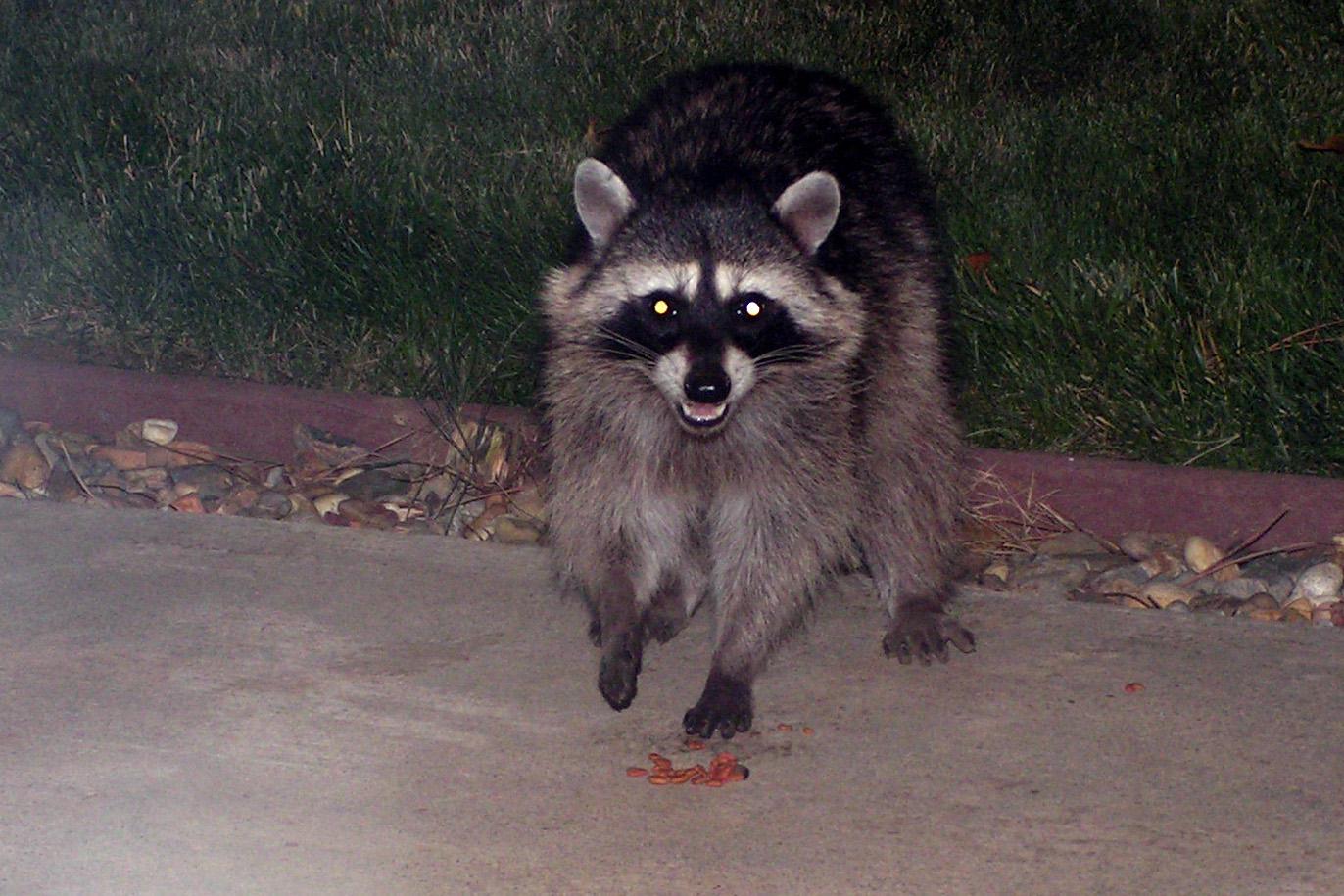
Racoons are probably the most common predator no matter where you live. From the rural-boondocks to the suburban and inner-city neighborhoods, these masked bandits are likely to be around.
Racoons are omnivores, meaning they will eat veggies, cat food, meat, whatever you give them a chance to eat.
What makes racoons so dangerous are that they are extremely dextrous, intelligent, and violent when they need to be.
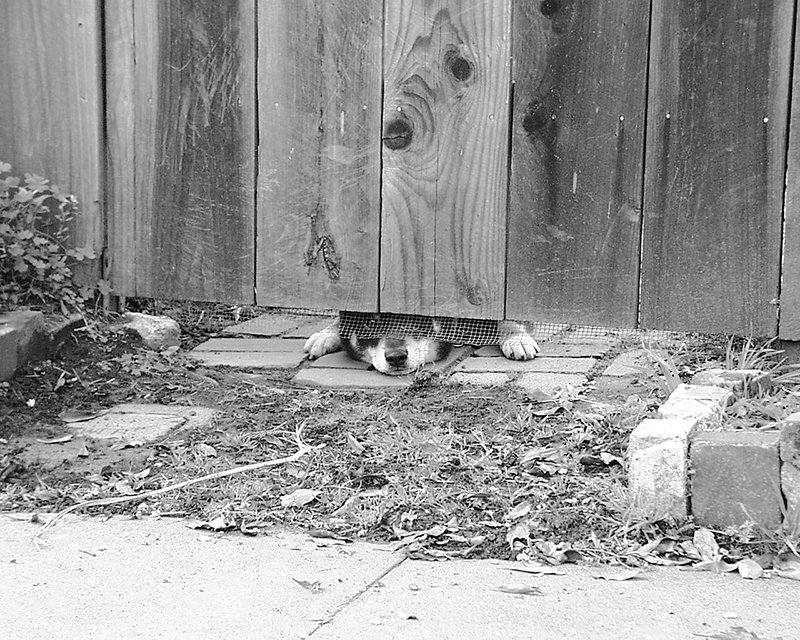
Loose dogs are another problem that happen in both rural and suburban areas. Many are perfectly friendly to humans, but they only see rabbits as prey. A rabbit left outside is at the mercy of all types of large predators, including mans best friend.
Why Outside is No Place for a Rabbit:
Small Predators
Fleas
Most people don’t realize that fleas love rabbits. If you live in a climate that has a warm spring and summer, fleas most likely live among you. Rabbits living outside is like handing the fleas a feast on a platter. It doesn’t matter if your rabbit lives high off the ground or not, fleas can jump extraordinarily high!
Fleas are nasty little bugs that can breed to infestation levels fast. Fleas feed on the blood of warm-blooded mammals such as dogs, cats, rabbits, wildlife, etc.
Besides being nasty little biting bugs, fleas feed on blood. When an animal becomes infested with fleas, the animal can quickly become anaemic. Anaemia is a condition of having low hemoglobin due to losing too much blood.
Rabbits can also develop a type of allergic reaction to flea bites. Symptoms include excessive scratching and itching. If left untreated, this can lead to lesions on the rabbit’s skin and thus causing a secondary skin infection.
To make the flea problem worse is that there are no flea medications made for rabbits. If you find fleas on your rabbit, you will need to visit your rabbit-savvy veterinarian asap. They will prescribe a safe flea medication for your rabbit with the correct dosing instructions. Please note, flea medications can be extremely toxic if given to the wrong species of animal. For example, never give a cat a flea medication meant for dogs. Dog flea medication given to cats causes seizures, neurological problems, and sometimes death.
Read More About Fleas and Rabbits:
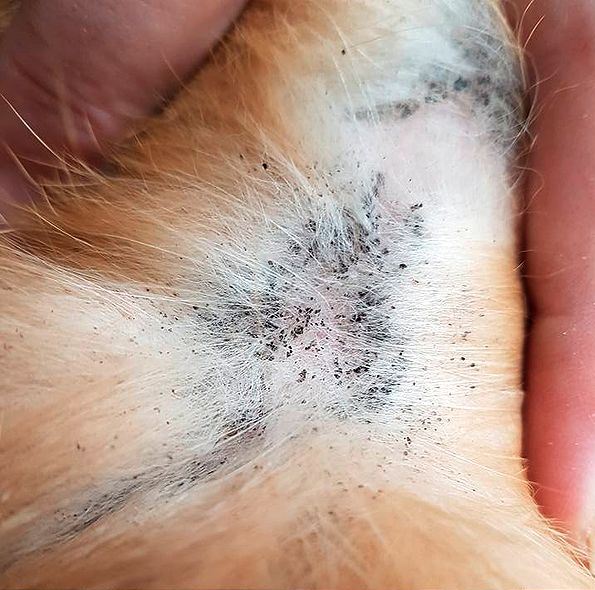
Many times, the only evidence of fleas on your rabbit are these little bits of black called “flea dirt”. It’s actually defecated blood. But it is a tell-tale sign that you have a flea problem.
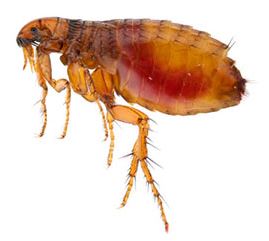
A close up photo of what a flea looks like. That red tint you see in the stomach is blood that they feed upon.
Ticks
Ticks are another tiny bug that plagues many animals, including rabbits. Like fleas, ticks also drink the blood of their hosts—in this case, rabbits. Unlike fleas, ticks lock-in to the host’s skin and fill themselves with blood until they’re ready to pop! This lock-in technique makes removal difficult, as their heads can pop off and remain embedded in the skin. So if you find a tick on your rabbit, don’t try and take them off by yourself, or you risk leaving the head behind. We recommend visiting your rabbit-savvy veterinarian. They can make sure all parts of the tick have been removed from your rabbit.
Generally, ticks tend to live and populate areas that are higher in elevation. They breed en masse in wooded and grassy areas where the creatures they feed on are available. Ticks feed on: deer, rabbits, birds, lizards, squirrels, mice, and other rodents.
Ticks are a flexible species. Populating urban areas as well as beaches in coastal areas. Ticks enjoy moist, humid environments.
Ticks like places close to the ground—among logs, fallen branches, tall brush, and grassy areas.
Young ticks (larvae and nymphs) are often found in piles of decomposing leaves.
As you can see, ticks breed and live in a wide range of environments. Whether you’re in the isolated woods of the wilderness, or somewhere as tame as a park, or your own backyard, you need to keep an eye out for these bugs. Ticks will happily bite and attach to humans as well if there are no animals readily available. Most people won’t know if they’ve been bitten by a tick because you can’t feel the bite. Experts recommend that after a trip to a wooded area to go home and strip search yourself for any hitchhikers. Besides being little blood-suckers, ticks carry several dangerous diseases. So know what a tick bite looks like for you and your family as well.
Areas with high tick populations struggle to keep them out of houses, let alone out of backyards. So, keep your rabbits inside. Because trying to keep ticks off an outside rabbit is like trying to keep bees from honey.
Read More About Ticks and Rabbits:
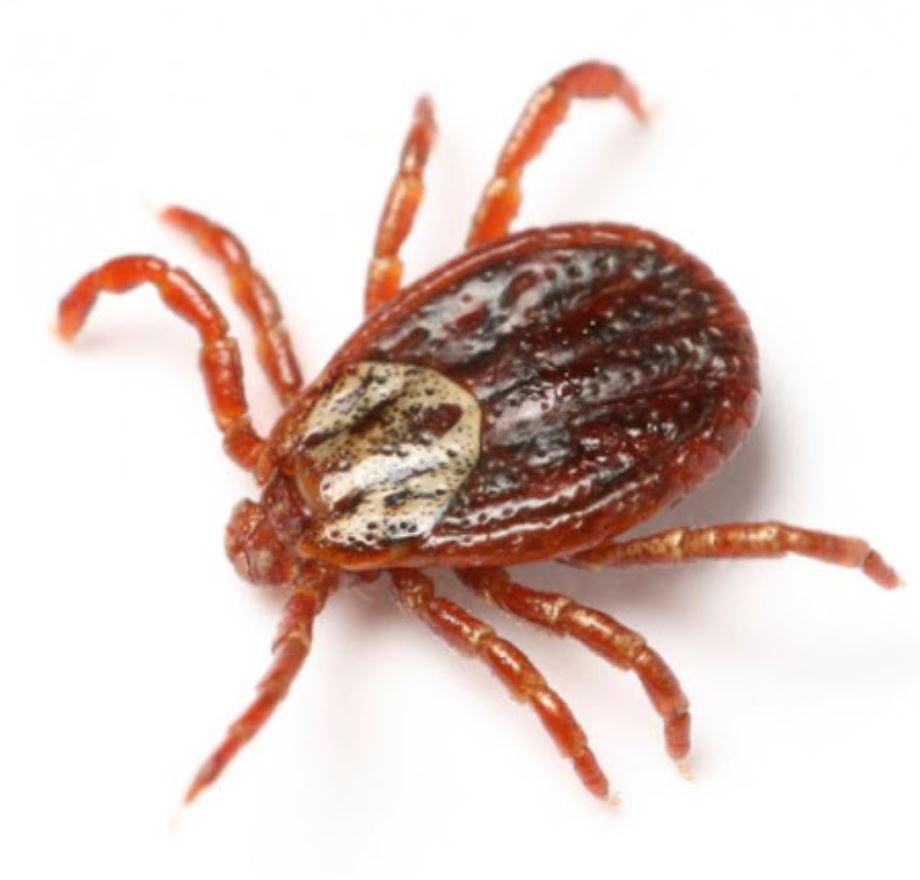
There are many species of tick, this is just an image of one kind. Ticks can be larger than fleas, or the same size, depending on the species of tick and the age. Photo Credit: Tick FAQs–this is a very informative page all about ticks.
Ticks are very good at finding crevices such as between the body and legs, or going down in the ear to attach and hide. So if you suspect your rabbit has a tick or two, it’s not a bad idea to take them to your rabbit-savvy veterinarian for a thorough body search.
The below is just an extra note we wanted to let people know about. The image is what certain tick bites can look like on humans. A reddened bulls-eyes type pattern. If you or a family member gets this mark, go see a doctor.
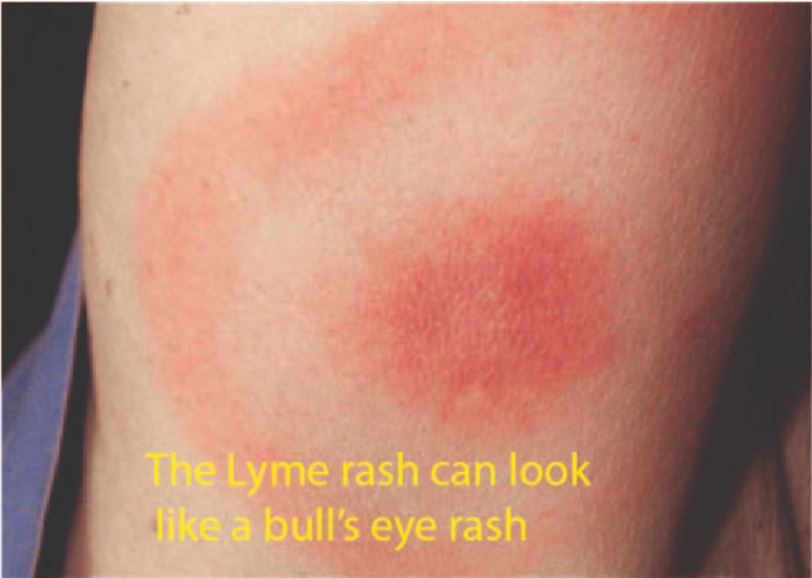
Mites
Mites are a common problem for rabbits kept outside. Mites that can infest rabbits range from fur mites and ear mites to burrowing mites that cause mange. Luckily, most mites are usually easy to get rid of. But the easiest way to avoid mites on your rabbit is to keep them inside your home.
Fur Mites
Fur mites that infest rabbits are most commonly caused by Cheyletiella spp. and less commonly Leporacarus gibbus.
The highly contagious Cheyletiella spp. mites are zoonotic (meaning they can infect multiple species, including humans). Cheyletiella spp. mites are common on cats and dogs too. Cheyletiella spp. mites infest humans temporarily when someone pets or holds an infested rabbit.Cheyletiella spp. mites cause skin irritation and itching in humans. Thankfully, they’re a non-burrowing mite and live on the skin’s surface layer.
Fur mites are often referred to as “walking dandruff” due to their large size which causes them to be visible to the naked eye.
Most rabbits do not show symptoms of a fur mite infestation. But for those that do, symptoms may include:
- Loss or thinning of hair along the shoulders and middle back of the rabbit.
- Dandruff-like flakiness.
- The fur can have the appearance of being “sprinkled” with pepper (which is you visually seeing the mites).
- Itching.
If you have sensitive skin, you may also experience some skin irritation when in contact with a rabbit with fur mites.
Ear Mites
Ear mites are the parasite known as Psoroptes cuniculi. This parasite can affect only one ear or both, and symptoms may spread to the rest of the body.
Ear mites are large and active and are visible to the naked eye. Ear mites stay on the surface and are nonburrowing. But that doesn’t make them any less annoying to the rabbit infected by them. Ear mites cause intense irritation when present in large numbers.
Rabbits can get ear mites through a few methods:
Exposure to affected rabbits in areas like pet stores, shelters, and multiple rabbit households. Exposure to fomites (disease-carrying objects) like hay, grass, straw, or bedding. Ear mites are found in all ages and either gender.
Ear mites produce abundant red-brown crustiness in the ear canal. Crustiness can also spread outside the ear, head, and neck. The rabbit may shake his head or scratch at his ears, or one or both ears may droop. This is a very uncomfortable condition but is easily treatable by a rabbit-savvy vet.
Burrowing Mites
There are two burrowing mite species, Sarcoptes scabiei and Notoedres cati. Both types are associated with mange in rabbits.
Mange caused by the mite Sarcoptes scabiei is known as Sarcoptic Mange.
Sarcoptes sp. mites are encountered all over the world, though not with equal regularity. Rabbits in northern Europe and England are rarely affected by this mange mite. While in Israel and subtropical humid regions, these mites are the number one cause of parasite skin infestations in rabbits. In the US it varies, depending on the region.
Sarcoptes sp. mites, or the Sarcoptic mange mites, present a zoonotic threat. Zoonotic means these mites can jump species, affecting dogs, cats, and humans. If a human gets the Sarcoptes sp. mite, it will cause a temporary itching dermatitis.
The other burrowing mite, Notoedres cati., causes Notoedric Mange and is a highly contagious mite that primarily infects cats. But this burrowing mite can also infect dogs, foxes, and rabbits. Notoedric mange is most commonly known as feline scabies. It is zoonotic as well.
Burrowing Mites Symptoms & Treatment:
Wounds appear first on the lips and nose. Later around the head, outer ears, neck, and sometimes around the genitalia. Burrowing mites will cause the rabbit to scratch, a lot. They will then also lick the affected areas, leading to alopecia (loss of fur).
Often, you can see watery-looking discharge that forms a yellow, “scaly”, or “crusty” layer once dry. Self-mutilation will lead to wounds and secondary bacterial infections in the rabbit.
Severe infestation of burrowing mites can lead to anemia and leucopenia. If left untreated, the rabbit will become lethargic and will die within a few weeks.
Thankfully, both types of mange can be treated by your rabbit-savvy veterinarian relatively easily.
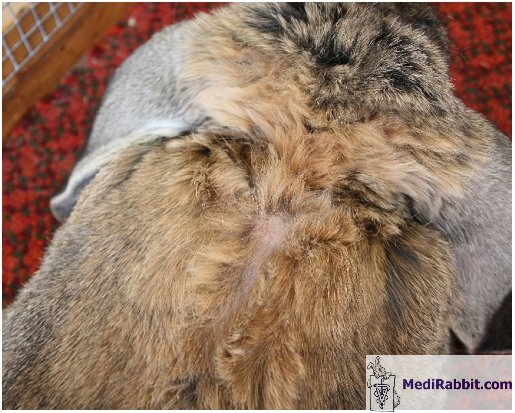
Photo Credit: MediRabbit’s–“Common Fur Mites or Cheyletiellosis”. The above image shows the hair loss and “dandruffy” appearance associated with fur mites.
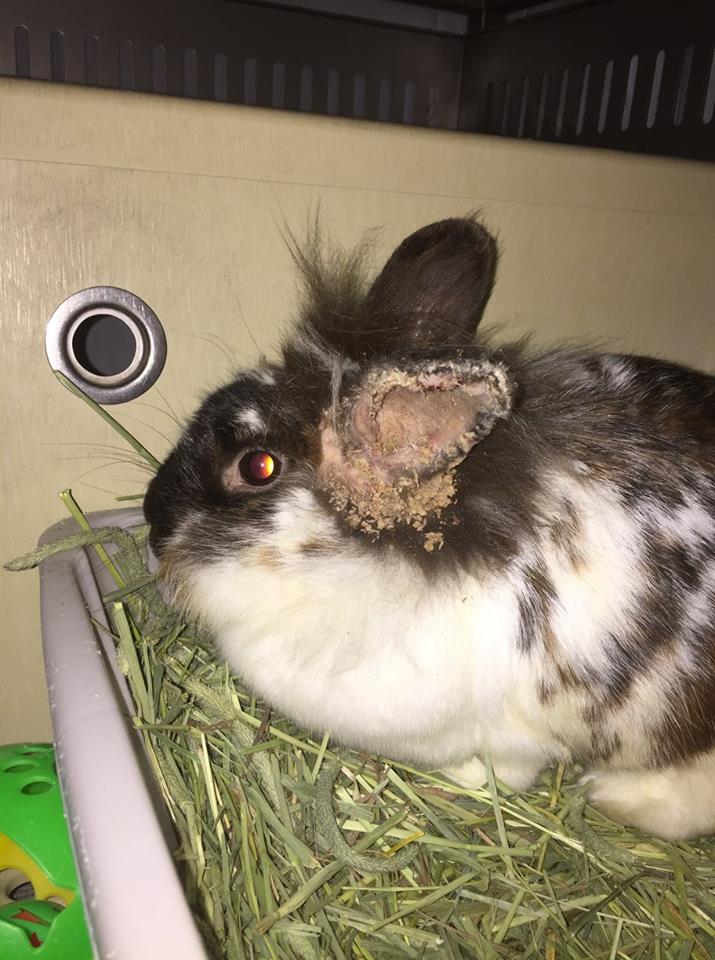
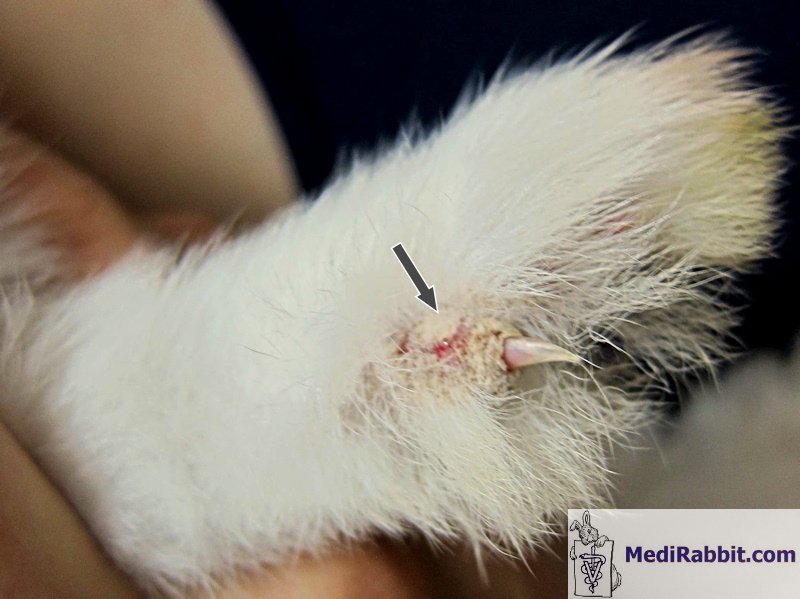
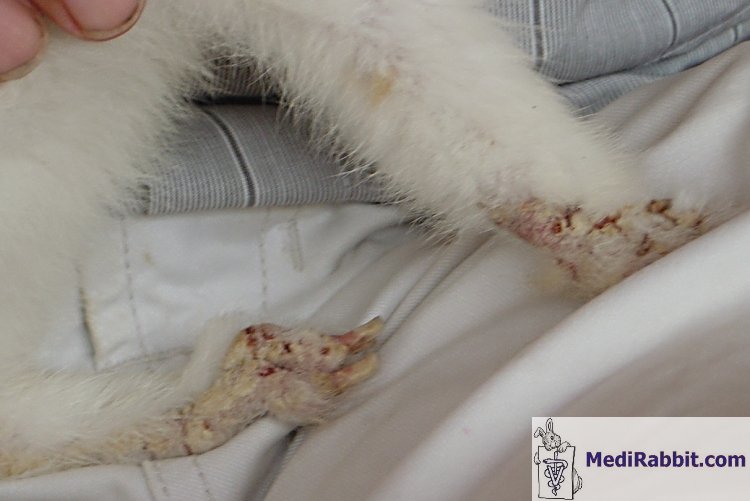
Read More About Fur, Ear, and Burrowing Mites in Rabbits:
Flystrike (aka Myiasis)
Flystrike occurs when certain types of flies lay their eggs on a rabbit. Those eggs then hatch into maggots in the rabbit’s skin. This is a horrible disease, as these maggots feed on the rabbit’s flesh. If not treated, this is condition is often fatal, due to infection or toxic shock.
Flystrike Causes:
Flystrike in rabbits is most common during warm weather–when flies are thriving. Flystrike is caused by several different fly species. Rabbits suffer in particular from the Blowflies (Lucilia sericata & Calliphora sp.), the Grey Flesh fly (Wohlfahrtia sp.), the common Screwworm fly (Callitroga sp.), the Botfly (Cuterebra sp), and the House Fly ( Musca domestica).
The scent of urine, feces, and blood attract flies. Therefore, they’re most likely to lay their eggs on injured animals, or those that are dirty and damp. In the world of pets, the common myth that rabbits belong outside in a hutch leaves them at the most risk for this terrible condition.
Flies can lay up to 200 eggs on the skin. You can usually find the majority at the rear end of an animal. These eggs then hatch into maggots within hours. The maggots grow by feeding on the rabbit’s flesh. Working together, these maggots can eat through a large area of skin frighteningly fast. The rabbit’s bottom, tail, belly, and back are usually worst affected. Rabbits who get flystrike can lose large parts of their flesh to these maggots within hours. The severe shock associated with this is often what kills them.
As you can see, due to the rapid development of flystrike, cases can become very serious in a very short space of time.
This is just another reason that rabbits should not live outside. Rabbits stuck outside in hutches for hours at a time alone can easily become affected and die before anyone notices.
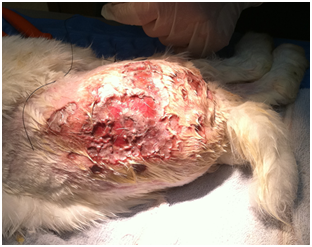
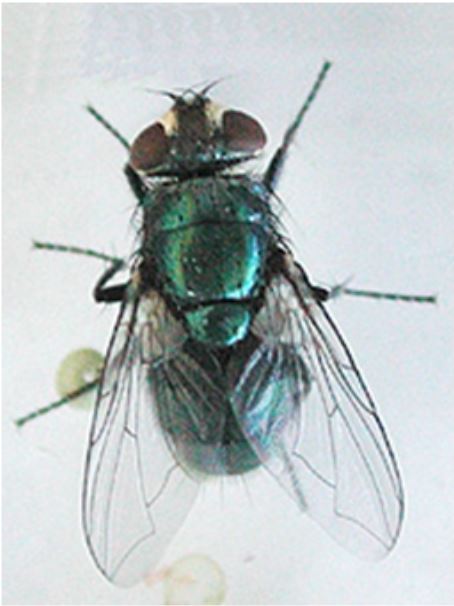
Flystrike Prevention:
The best prevention is to keep your rabbit inside away from the radar of most flies. Living inside also allows you to ensure your rabbit and their pen stays clean, which will keep flies away.
It must said that this condition also happens with rabbits who live inside because flies can get in too. However, it’s a lot easier to catch if you’re right there with your rabbit and not visiting to a hutch once or twice a day.
You want to try to rid the area of things that attract flies.
Keep everything dry! If the litter box is full of urine and feces, dump it far away from the house and your rabbit. If your rabbit has poopy-butt syndrome, do not dip their rear end in a bath to clean it. This can take too long to dry can cause the perfect environment in the wet fur. Besides, a rabbit with poopy-butt has something else going on and should see a rabbit-savvy vet. If you can’t get to the vet asap, in the meantime you can “spot clean”. Spot cleaning will still help loosen and remove feces stuck to the hindquarters.
If you have a long-haired breed such as an Angora or Lionhead, talk to your rabbit-savvy vet to learn how to keep certain areas shaved. This will help allow those areas such as their bottoms that see a lot of moisture to stay dry. It will also allow you to see the area better and keep an eye out for maggots.
What To Do If You Suspect Flystrike
Flystrike in rabbits is life-threatening. You need to contact your vet straight away if you suspect your rabbit has flystrike or if you find a maggot on your rabbit or in their cage. If it’s out of hours, call your nearest 24/7 Emergency Animal Hospital. Do not wait until your daytime rabbit-savvy vet reopens as it may be too late.
Flystrike Warning Signs:
Seizures: Some rabbits have “itchy skin” seizures. Caused by nerve sensors on the surface of the body triggering an overall nerve reaction. Rabbits are sensitive to surface irritations, and maggots eating your flesh can cause the body to react this way. These “itchy-skin” seizures can be an early warning sign. If your rabbit has a seizure but you can’t find anything on their hind end or stomach, check near their scent glands. Not all rabbits respond this way, but it’s good to know some do.
Lethargy or inactivity: This is never a good sign in a rabbit. It usually means something is wrong. In the case of flystrike, the rabbit may already be in shock.
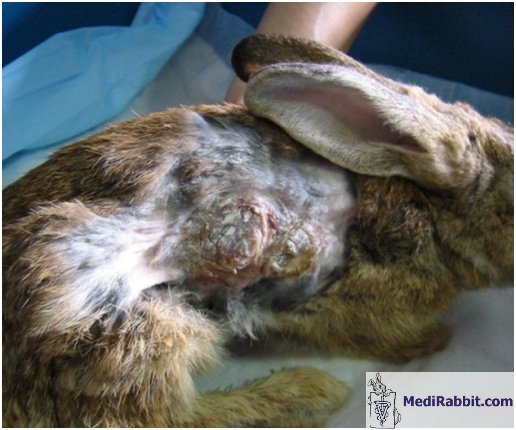
More Flystrike Resources and Information:
Racoon Roundworm
The Raccoon Roundworm (Baylisascaris procyonis) is a common large roundworm (a parasitic worm) that lives in the small intestines of raccoons.
Rabbits exposed to any outside environment may contract this parasite by ingestion.
Raccoons are everywhere, from the most isolated wilderness to the most urban backyards; making this parasitic disease especially dangerous.
Raccoons carry this roundworm parasite in their intestines. When they defecate, they also excrete the roundworm parasite as well. The parasite can live for some time in soil that has had the fecal remains from an infected raccoon. A rabbit nibbling on grass or hay in the same area will then accidentally ingest this parasitic worm.
In rabbits, this roundworm does something pretty scary. The roundworm migrates to the rabbit’s central nervous system–the brain. Once in the brain, it causes a condition known as Secondary Encephalitis. This condition causes inflammation and infection in the rabbit’s brain and surrounding tissues.
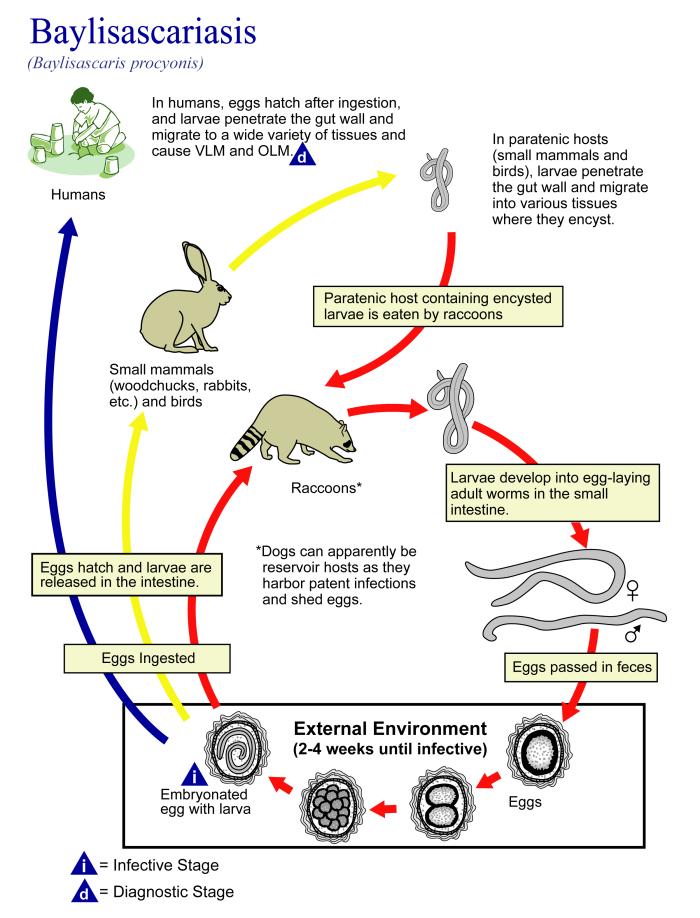
Racoon Roundworm Symptoms and Treatment:
Symptoms can vary according to what area of the brain is affected. But head tilt (torticollis) is one of the most common symptoms. Due to this being an infection of the brain there may be motor (movement) problems with other body parts.
Certain antibiotics can be given to target the brain infection. Corticosteroids can also be given to relieve the inflammation and swelling of brain tissue. The involvement of the central nervous system makes this a particularly dangerous infection. Unfortunately, this is a difficult infection to diagnose, and most cases are not diagnosed until after the rabbit has died.
If the onset of symptoms is sudden, the disease may progress rapidly, warranting euthanasia to prevent suffering.
Once again, prevention is key. Keeping your rabbit safely inside your home keeps the risk of them contracting this parasite very low.
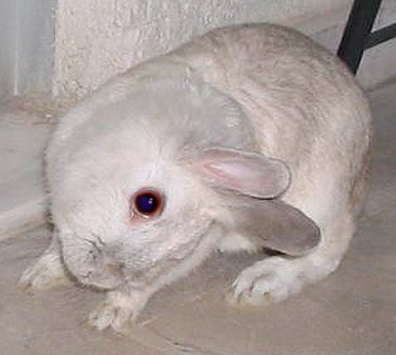
More Racoon Roundworm Resources:
Why Outside is No Place for a Rabbit:
Disease
Rabbits living outdoors are exposed to a wide variety of diseases. Some of the most wide-spread dangers are listed below. But each state and country have their own unique set of disease threats. So it’s a good idea to research rabbits diseases in your local area. The one common thread in all of these diseases is that the best way to prevent your rabbit from getting them is to keep them inside the home. Rabbits should not live outside because of the very real threat of these diseases.
Rabbit Hemorrhagic Disease Virus (RHDV & RHDV2)
Rabbit Hemorrhagic Disease Virus (RHDV2): Rabbit Hemorrhagic Disease Virus (RHDV) is a highly contagious disease caused by a calicivirus. It can not be stated enough how highly transmittable this virus is. While RHDV2 only infects wild and domestic rabbits, it is a devastating disease.
We want to make this very clear. It is hard enough to keep this virus from your rabbit if they live inside. It is impossible to prevent infection if your rabbit lives outside, and you live in an area where RHDV is present. See more about how this particular virus is spread and you’ll understand why it is such a threat to any rabbit with outside exposure.
RHDV2 did not make landfall in the United States until 2020, but this virus has been around Europe, China, and Australia for years.
The 2020 Southwest outbreak confirmed RHDV2’s presence in the U.S., much to everyone’s dismay. RHDV and RHVD2 (two different viral strains) affect domestic and wild rabbits.
What makes RHDV2 so terrifying as a virus is that it is often a very swift and sudden killer, giving little warning. Rabbits may die without showing any symptoms at all. Any sudden rabbit deaths in the home or in the wild are considered suspicious and should be reported to your veterinarian. This is the only way we can track the virus’s spread as it makes its way across the US through the wild rabbit populations.
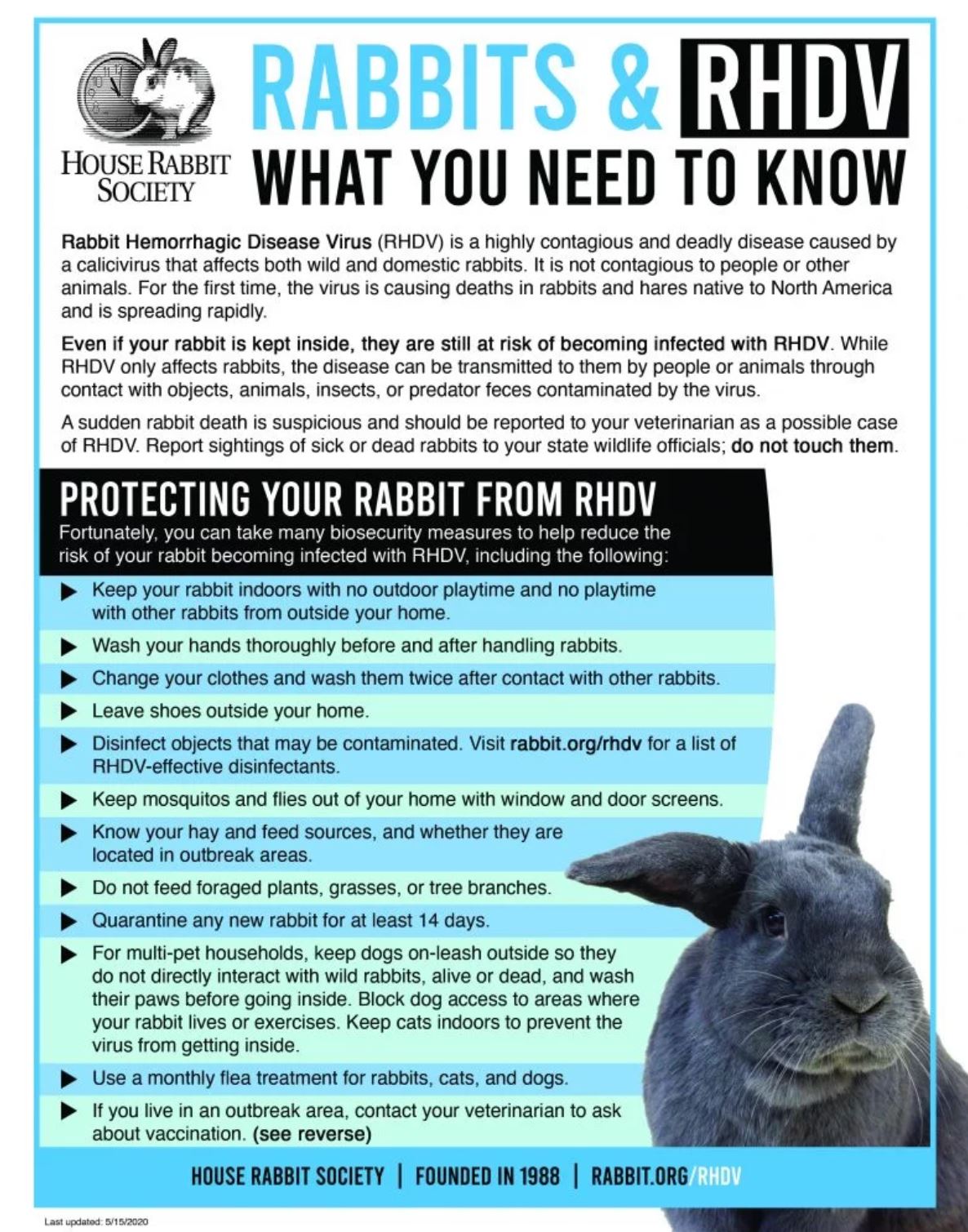
How RHDV & RHDV2 are spread:
RHDV & RHDV2 are both extremely contagious. These viruses are spread by:
- Direct contact: A rabbit comes into contact with an infected rabbit or the urine or feces of an infected rabbit.
- Indirect contact
- Human contact: While people can’t contract this virus, they can spread it to their rabbits. A person coming into contact with an infected rabbit or contaminated objects can bring the virus home to their rabbit. Because this disease is so swift to kill, if someone comes in contact with an infected rabbit, they most likely weren’t showing any symptoms, yet.
- Inanimate objects: A rabbit can catch this virus by coming into contact with contaminated objects. These are known as fomites and include clothing, shoes, and automobile tires. A person walking across unseen feces or urine from an infected wild rabbit will accidentally bring the virus home on their shoes.
- Rabbit products: Contact with fur, meat, or wool from infected rabbits. Since this virus does not affect humans, rabbit product manufacturers are less keen on keeping things sterile from this virus.
- Mechanical Vectors and Predators: Insects (flies, fleas, and mosquitoes), birds, rodents, large predators, and other pets (cats and dogs) can spread the virus by acting as “indirect hosts” or “mechanical vectors”. While other animals are not harmed by RHDV2, they can transport it from an infected rabbit to a healthy rabbit. In Australia, flies who’d been in contact with infected rabbits are thought to have been the primary cause of long-distance viral transmission. RHDV can be excreted in the feces of predators who have consumed sick rabbits.
- Food/Water: Ingesting virus-contaminated water or food.
RHDV & RHDV2 Incubation, Symptoms, and Death Rate:
RHDV is often a very swift and sudden killer, giving little warning. Rabbits often die without showing any symptoms at all.
Incubation (Development of Infection) Period:
- RHDV1 1-3 days. Rabbits may die within 12-36 hours to a few weeks, after the onset of symptoms.
- RHDV2 3-5 days
If a rabbit does show symptoms of RHDV or RHDV2, they include:
- Loss of appetite
- Lethargy (low energy, not very responsive)
- High fever
- Seizures
- Jaundice (yellowing of the eyes and skin)
- Bleeding from nose, mouth, or rectum
- Difficulty breathing
- Sudden death
Death Rate:
- RHDV 40-100%
- RHDV2 5-80%+
- Survivors: Rabbits who survive RHDV are carriers and shed the virus for at least 42 days.
- Asymptomatic Carriers: Some rabbits may show no signs of having the virus, but may shed virus for up to 2 months.
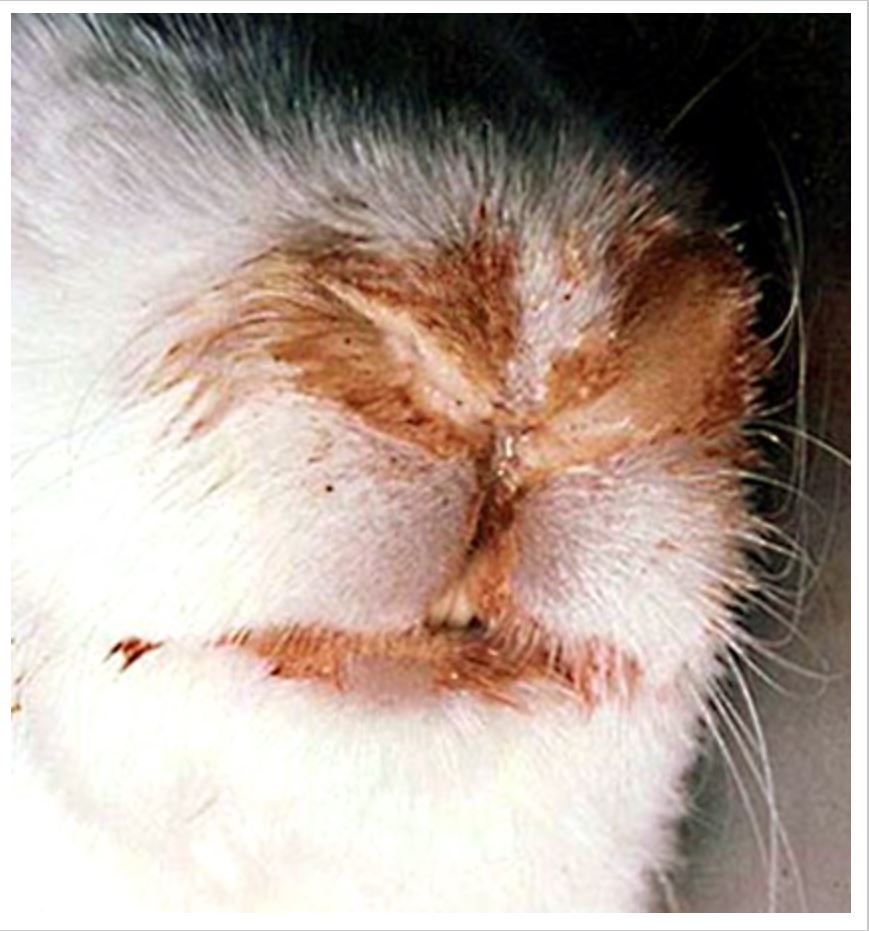
RHDV & RHDV2 Treatment and Prevention:
- There is no known cure for RHDV
- There is a vaccine that can help protect your rabbit from catching this virus. Several states with the virus have the vaccines in. Learn more about the vaccine and it’s availability in each state here.
- But even with a vaccine available, it must be given before your rabbit comes into contact with the virus. The vaccine will not work once your rabbit has already been infected
- RHDV treatment is supportive symptom care in isolation
- There are currently no known effective anti-viral drugs or other treatments available

More RHDV Resources:
- Rabbit Hemorrhagic Disease PDF – The Center of Food Security and Public Health
- Rabbit Hemorrhagic Disease Virus (RHDV) – House Rabbit Society
- Molecular epidemiology of Rabbit Haemorrhagic Disease Virus (RHDV) in Australia: when one became many-US Library of Medicine & National Institutes of Health
- Invasive Species Compendium-rabbit haemorrhagic disease – CABI
Myxomatosis:
Myxomatosis is a virus that has a 99% mortality (death) rate in domestic rabbits. There is no treatment.
Wild rabbits can be infected with the Myxomatosis virus and show no symptoms. Making them what is known as asymptomatic carriers.
How is Myxomatosis Spread?
Myxomatosis is a vector-borne disease. One of the main modes of transmission is through a “disease-vector”. Vectors can be mosquitoes, flies, fleas, or fur mites. These vectors bite an infected rabbit, and then hop or fly over to a healthy rabbit, biting them and spreading the virus.
This virus is also spread through modes know as direct and indirect contact.
- Direct contact happens when an infected rabbit comes into contact with a domestic rabbit, spreading the virus through the air.
- Indirect contact happens through a person handling a sick rabbit, then handling a healthy rabbit. Surfaces and objects can also maintain the virus for a time, assisting in its spread.
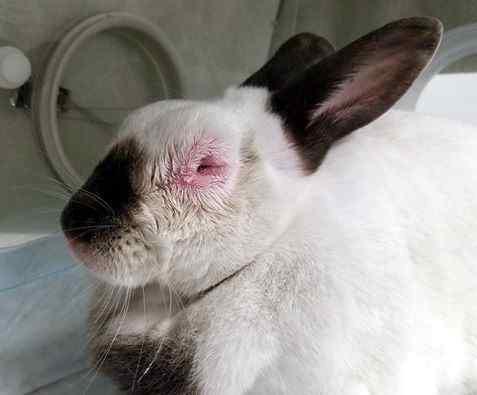
Myxomatosis Symptoms:
Myxomatosis Symptoms Include:
- swollen eyelids, lips, and genitals
- high fever
- lethargy
Symptoms quickly progress to difficulty breathing, and death, within 2 weeks.
Myxomatosis Treatment and Prevention:
Unfortunately, there is no cure, and supportive symptom care is generally unsuccessful.
To prevent myxomatosis, your best options are to do the following:
- Control its vectors – add screening to keep out insects; use flea control; keep your rabbits indoors.
- Disinfect surfaces regularly – 10% bleach, 10% NaOH, 1% to 1.4% formalin
- Quarantine new rabbits and do not house wild rabbits with domestic pet rabbits.
- Vaccinate your rabbits if it is available in your country. It can provide temporary protection. Unfortunately, the vaccination is not available in Australia or the United States.
More Myxomatosis Resources and Information:
- Myxomatosis in the US – House Rabbit Society
- Myxomatosis – WabbitWiki
- Myxomatosis – World Organisation for Animal Health
Why Outside is No Place for a Rabbit:
Weather & Temperature
Last, but definitely not least in the list of reasons rabbits should not live outside, is the weather. Specifically, temperature.
Overheating in Rabbits
Domestic rabbits are very sensitive to overheating.
Like dogs and cats, rabbits don’t sweat all over their body like humans do to cool themselves. Rabbits control their body temperature through their ears. But when temperatures rise over 80 degrees Fahrenheit or higher, rabbits will begin to overheat.
Symptoms of Overheating in Rabbits:
If a rabbit starts overheating and nothing is done about it, they can quickly die of heat-stroke.
Signs of a rabbit overheating are:
- Fast, shallow breathing
- Hot ears
- Listlessness or Lethargy
- Wetness around the nose area
- Tossing their head back while breathing rapidly from an open mouth.
If you see any of these signs, you need to cool the rabbit down ASAP. Get them in the shade, or better, air-conditioning. Dampen the ears with cool (not cold) water as this will help to bring down his/her body temperature. Rabbit’s ears are his/her personal air conditioner. Give the rabbit access to fresh, cold water with a few ice cubes in it, and call your rabbit-savvy vet for further instructions. Do not try and cool the rabbit down by giving it a cold bath or submerging them in any water. This will just put them into shock and likely kill them.
Preventing Heatstroke in Rabbits:
Just like in humans, heatstroke in rabbits is a very serious condition. But it is 100% preventable!
The #1 way to prevent heatstroke in rabbits is to keep indoors. Rabbits who live indoors rarely have issues with overheating because homes are temperature-controlled. We recommend keeping your AC at 78 degrees Fahrenheit or lower during the hot summer months. But even at 78 F, some rabbits have a tendency to overheat. For those sensitive rabbits, there are some other things you can do along with AC to keep them cool.
Things to Help Keep Your Indoor Bunnies Cooler:
- Frozen Water Bottles: Place frozen water bottles in the rabbit’s cage where they can lay next to them. These bottles not only help keep the rabbit’s body temperatures down, but they can also lick the cool condensation.
- Ice Cubes in Water Source: Placing ice cubes in their water bottles also helps keep things cool.
- Stand-up Fans: Can help keep your rabbit cooler during warm temperatures.
- Provide Cool Surfaces: Get several tiles (stone or ceramic) and place them in your bunny’s area. They stay naturally cool, but you can also put them in the fridge or freezer to chill them more. Do not use wet blankets and towels as this wets your bunny and leaves them vulnerable to flystrike.
- Create Frozen Treats: Make 100% fruit juice popsicles in an ice tray, or water with fruit inside. Even though these are likely to be a huge hit, fruit popsicles contain a lot of sugar and should be given sparingly.
- Extra Grooming Sessions: Helping your rabbit to rid themselves of excess fur will help cool them down.
With Hot Weather Remember to:
- Have Extra Water Available: In the summertime always make sure extra water is available for your rabbit. Even if they live inside, they’re likely to drink more water during the hot months.
- Keep Water Sources Clean: With warmth comes bacterial growth. Be sure to clean all water bottles/crocks thoroughly and regularly to prevent bacteria from growing.
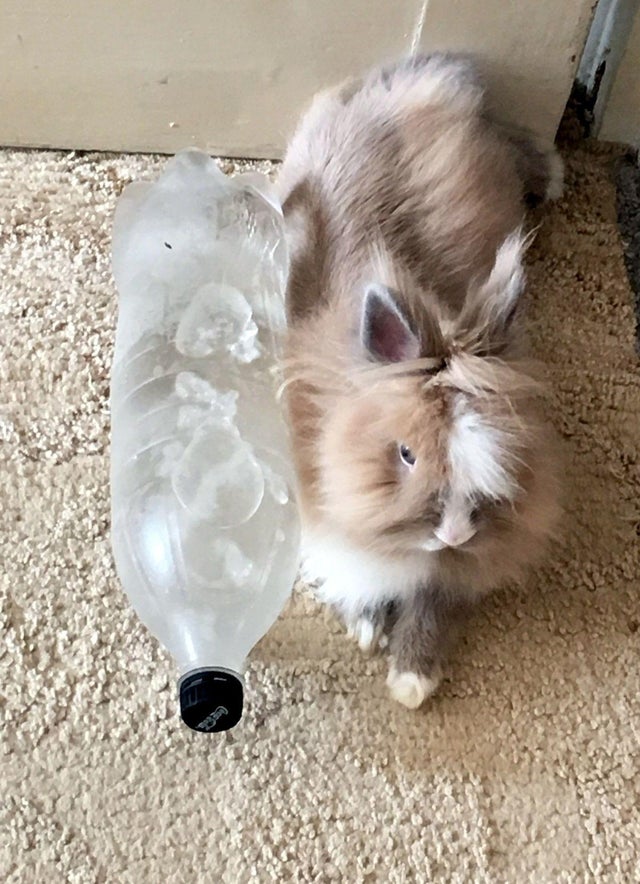
Outside is No Place for a Rabbit, Especially in the Summer Months:
While you already know House Rabbit Resource believes rabbits should not live outside, we also strongly urge caretakers to not take rabbits outside for playtime or walks when temperatures are over 78 degrees Fahrenheit. Besides the risk of overheating, warm weather also brings a higher risk of your rabbit getting fleas or flystrike.
Never use wet towels outside to try and keep your rabbit cool. This will attract flies and increase flystrike chances.
More Hot Weather and Rabbits Information:
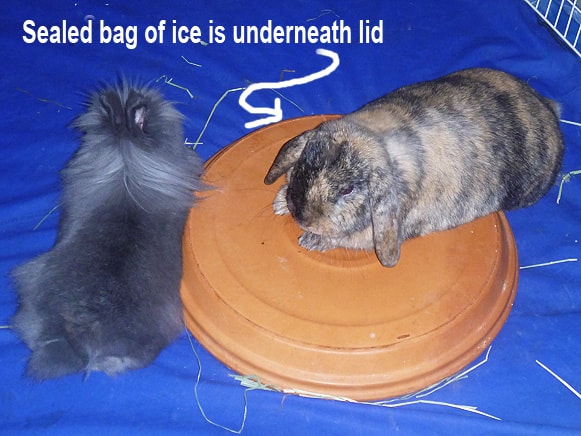
Photo Credit: Celine who sent the photo to BinkyBunny.com.
Photo is of a Terracotta Lid with Ice bag underneath:
“Get lids big enough for bunnies to lay most of their body on. I lay a smaller flat dish on the ground and fill a bag with ice and put it in the dish and flip the plant lid over on top of it to make an ‘ice bed’. My bunnies love to lay on these to help dissipate the heat. On days that are cooler to me and under 75, I know that they are getting hot when they get up on these beds when there is no ice in them signaling to me that they need cooling off and I go fill them up.”
Keep Your Bunny Cool In Summer Time Quick Tips:
- Do not let rabbits remain in temperatures 78° F (25.5° C) or higher
- Keep them cool inside with AC set to 78°F (25.5° C) or lower
- Use stand-up oscillating fans
- Keep rabbit out of direct sunlight
- Place frozen water bottles near rabbit
- Mist ears with cool water (do not drench)
- Offer chilled ceramic tiles to lay on
- Add ice to water sources
Overheating and Heatstroke are EMERGENCIES.
Know the Symptoms. Know How to Prevent.
Cold Weather and Rabbits
Rabbits are cold-weather animals. While they can’t handle the heat well at all, their bodies handle cold weather much better. Rabbits tolerate temperatures down to freezing 32°F (0°C).
You can rest easy knowing that your rabbit is fine in your home in the winter. More than likely your rabbit will handle any chill better than others in the house–human or animal.
Keep the heat on to your comfort level (unless that’s over 78 °F) and your rabbit will also be comfortable.
Because HRRN does not support rabbits living outdoors at any time of the year, there is not much else to discuss on the colder temperature subject. We do want to note that rabbits while rabbits handle cold well, they can still get hypothermia (when body temperature drops below 101°F (below 100°F is serious!). A rabbit in a hutch outside in winter will begin to suffer at around 30°F (-2°C).
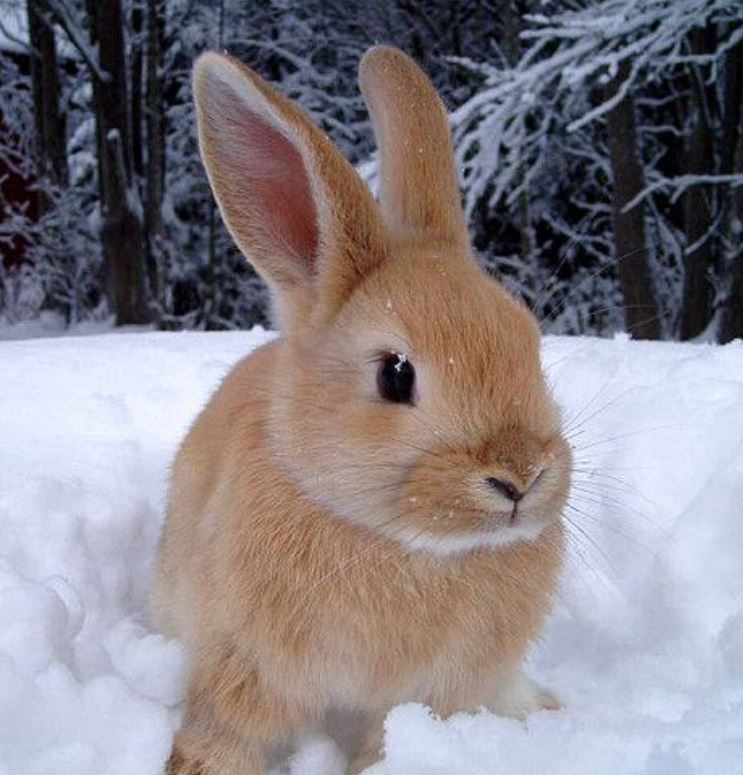
Barometric Pressure Changes and Rabbits
Alright, so this next section is entirely based on experience, but we felt it necessary to mention as many people don’t know about it.
Barometric pressure (also known as atmospheric pressure) is the force exerted by the atmosphere at a given point. It is known as the “weight of the air”. Fluctuations in barometric pressure are usually a sign of weather conditions. So when that cold-front comes through after it’s been super hot out, it causes a sudden change in barometric pressure.
Due to a home being temperature-controlled, a rabbit living inside is less likely to be affected by barometric pressure changes. But that’s not 100% and sensitive rabbits can still have issues. It’s a good idea to keep an eye for differences in your rabbit during extreme weather changes. At HRRN, we’ve found some rabbits are sensitive to these changes, and it can actually cause gut stasis.
While we couldn’t find any articles to support this theory in rabbits, barometric changes have been linked to colic in horses. Horses and rabbits are similarly designed animals with colic in horses being the equivalent to gut stasis in rabbits. And like we stated earlier, we’ve seen this theory to be true. Certain rabbits at our shelter will have gut stasis issues in line with a big change in the weather that day.
“When barometric pressure drops, some horses that are a little more prone to colic, you can almost guarantee that they’ll colic,” Slovis said. (Colic And Weather Changes: What You Can Do To Protect Your Horse. Horse Racing News: Paulick Report.)
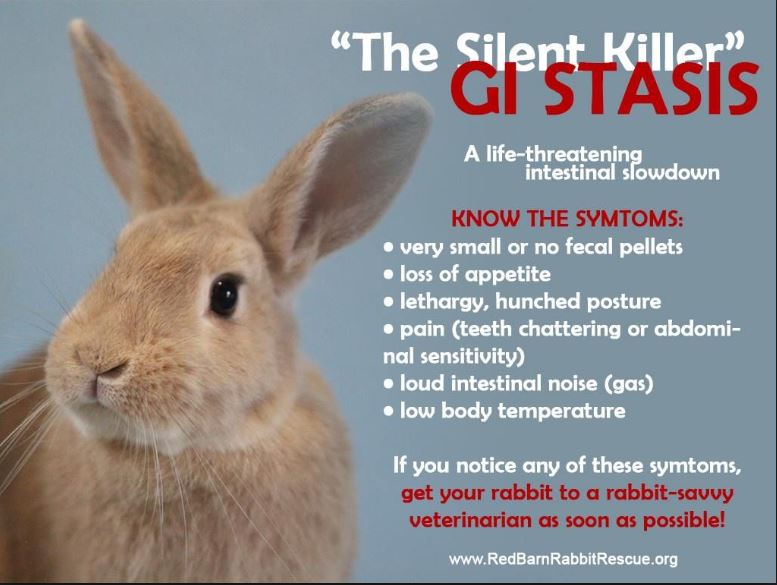
Gut Stasis can be deadly. Know the signs so that you can begin treatment at the earliest signs of gut stasis. Learn more on our Gut Stasis page.
Why Outside is No Place for a Rabbit:
Compare and Contrast
A Rabbit Living Inside is:
- Safe from predators, both large and small.
- Protected from parasites and disease.
- Protected from life-threatening weather extremes.
- Closely watched and therefore health problems are more likely to be caught early. This ability benefit can be the difference between life and death.
- Much more likely to form a strong connection to their caretakers and other pets in the home.
- Not at risk for theft or harassment from strangers.
- More likely to live a long, happy life. The average lifespan of an indoor house rabbit is 8-14 years. The average lifespan of a rabbit kept in an outdoor hutch is 3-6 years.
- More healthy both mentally and physically as they are part of the social dynamic of the family.
A Rabbit Living Outside is:
- At the mercy of large predators waltzing into their area. Remember, even if an animal can’t get into a cage to kill the rabbit, it can still cause the rabbit to injure itself or die of fright.
- The risk of contracting a disease or parasite is extremely likely.
- Exposed to all weather extremes. Rabbits do not tolerate weather about 80 degrees Fahrenheit.
- Often forgotten and/or neglected.
- Not given the daily opportunity to run and play.
- Not given the social interaction they crave and need.
- Likely to become bored, depressed, and stressed. Living outside in a hutch or cage is like living in solitary confinement.
- Less likely to form a strong bond with their human caretakers due to lack of regular interaction.
- More likely to die young. The average lifespan of a rabbit kept in an outdoor hutch is 3-6 years. The average lifespan of an indoor house rabbit is 8-14 years.
See the Difference
Inside Rabbits
Outside Rabbits
Why Outside is No Place for a Rabbit:
Frequently Asked Questions
Like we stated in the intro of this page, the topic of rabbits not living outside is a heated one. Whenever HRRN or other house rabbit rescue groups bring up the reasons why house rabbits should not live outside, we get lots of questions and counter-arguments.
We understand many people feel very strongly about keeping their rabbits outside. They feel attacked when we try to explain why rabbits should not live outside. We understand that most people are not keeping their rabbits outside to be neglectful or inhumane. But the facts are that rabbits who live outside have drastically shorter lifespans and increased health issues.
On top of facts and statistics, rabbit-savvy veterinarians specially trained in the care and health of house rabbits recommend they live inside.
We know we’re fighting a deeply engrained belief here. It’s a hard practice to change, one that has been handed down for generations. But we believe that offering and explaining the facts is the first step to changing this pattern. Things are known now, that were not known back then. Lots of things that were once considered “good” or “normal” are now recognized as being bad and harmful. The case of rabbits living outside is no different.
Here are some of the most common questions or arguments about keeping rabbits outside and our responses.
House Rabbit Resource Network
Other Pages on Rabbit Housing
What to Expect Living with a Rabbit

